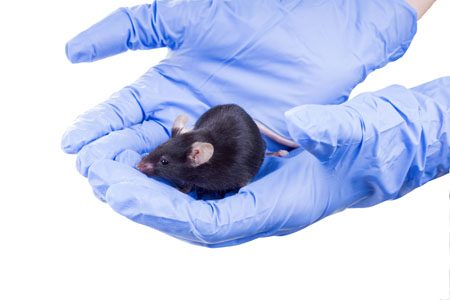Eye Movement Desensitization and Reprocessing Can Improve PTSD
A 2014 meta-analysis of clinical trials showed that the therapeutic technique known as eye movement desensitization and reprocessing (EMDR) can reduce symptoms of post-traumatic stress disorder (PTSD). The meta-analysis also established that longer durations of EMDR treatment correlated with better outcomes.
The meta-analysis by Ying-Ren Chen and colleagues in the journal PLOS One evaluated 26 randomized controlled trials of EMDR in people with PTSD. Chen and colleagues found that EMDR reduced PTSD symptoms, depression, anxiety, and subjective distress.
EMDR is a psychotherapeutic technique intended to reduce the distress that a patient feels about a traumatic memory. The patient is encouraged to recall the traumatic event while focusing on an external stimulus. Typically this would mean using their eyes to track the therapist’s hand moving back and forth from left to right. This process can help patients reprocess the trauma and alleviate the stress that they feel upon recalling the traumatic memory.
Chen and colleagues found that EMDR sessions that lasted longer than one hour were more effective than those that lasted less than an hour. Another finding that was that groups led by therapists who were experienced in PTSD group therapy were more effective than groups led by therapists without that experience.
Other more recent research has established that traumatic memories can be reprocessed or even extinguished by making use of the memory reconsolidation window. Five minutes to one hour after a patient engages in active emotional recall of a traumatic memory, a window of time opens in which that memory is subject to reinterpretation and revision.
An experienced therapist can create a safe environment for a patient to recall traumatic events and find alternative ways of interpreting the experience—for example, by focusing on their strength in surviving the experience. This process resembles EMDR in many ways, but without the eye movements.
In a 2017 article in the journal Psychiatry Research, BNN Editor-in-Chief Robert M. Post and colleague Robert Kegan discuss the possibility of using the reconsolidation window to reprocess stressors that led to a depressive episode.
Immune Response to Repeated Stress Alters Behavior in Mice
In research presented at the 2016 meeting of the Society of Biological Psychiatry, Jonathan P. Godbout described how an immune reaction to repeated stressors may lead to anxious behaviors in mice.
Mice were repeatedly defeated by a larger animal, a form of stress that produces a depression-like state. This provoked an immune response in the mice—the release of a type of white blood cells called monocytes from the bone marrow into the circulatory system. These inflammatory monocytes then traveled to the brain and spleen, attracted by signaling proteins called chemokines. The monocytes in turn produced inflammatory marker interleukin-1beta.
The defeat stress also provoked a reaction in the central nervous system, where microglia were activated.
These changes produced inflammation and anxiety-like behaviors in the mice. Blocking the microglial activation, monocyte recruitment to the brain, or interleukin-1beta signaling each reversed the anxiety-like behaviors.
Another researcher, Scott Russo, has shown that leukocytes, another type of white blood cells, secrete inflammatory interleukin-6 following defeat stress, and blocking this secretion prevents defeat stress–related behaviors.
Inflammation Predicts Depression and Anxiety Four Years Later in Older Americans
A large study of retired Americans found that those with high levels of the inflammatory marker C-reactive protein in the blood had more depression and anxiety. Higher CRP also predicted severity of depression and anxiety four years later.
The study, by researchers Joy E. Lin and Aoife O’Donovan, included 18,603 people over age 50 from the Health and Retirement Study. It was presented at the 2016 meeting of the Society of Biological Psychiatry.
Lin and O’Donovan hope that treating or preventing inflammation may be the key to preventing symptoms of depression and anxiety.
Vegan Diet Can Lead to Vitamin B12 Deficiency
Vitamin B12 deficiency is a risk associated with a vegan diet. B12 deficiency can lead to depression, anemia, and even irreversible neuron damage, according to researcher Drew Ramsey, who spoke on the topic at the 2016 meeting of the American Psychiatric Association.
A study of vegans showed that 52% were deficient in vitamin B12, while another 23% had insufficient levels of the vitamin. B12 is found in the highest concentrations in certain seafoods and liver. It is also found in dairy products, eggs, fortified breakfast cereals, and is available in supplement form.
Women who eat a vegan diet while pregnant may not be providing their offspring with enough nutrients, according to researcher Emily Deans, who also spoke at the meeting. A case report on 30 vegan mothers found that 60% of their offspring had developmental delays and 37% showed cerebral atrophy.
Deans said that eating no meat is associated with higher rates of depression, anxiety, and worse quality of life.
Ramsey believes that while the North American diet is probably weighted too heavily toward animal products, seafood remains an important source of B12.
Mindfulness Therapy Improves Anxiety in Youth with a Bipolar Parent
Children of parents with bipolar disorder are prone to anxiety and emotional dysregulation, but treating these symptoms with antidepressants can provoke symptoms of mania. Thus, non-pharmacological treatements for anxiety and depression are needed. A recent study by Melissa DelBello found that twelve weeks of mindfulness-based cognitive therapy improved symptoms of anxiety and mood dysregulation in 20 youth with a bipolar parent. DelBello used functional magnetic resonance imaging (fMRI) to observe that the therapy increased activation of brain structures related to emotion and sensing. Amygdala activation differed between those with anxiety and those with mood dysregulation, suggesting that the therapy’s effect was on regions that modulate the amygdala, including prefrontal and insular regions, rather than on the amygdala itself.
Mice Who Witness Another Being Attacked Show Depression-Like Behaviors
 Stress is a risk factor for depression and other mental health disorders. Researchers are currently working to clarify how stress leads to depression, anxiety, and post-traumatic stress disorder, and why trauma early in life has lasting consequences.
Stress is a risk factor for depression and other mental health disorders. Researchers are currently working to clarify how stress leads to depression, anxiety, and post-traumatic stress disorder, and why trauma early in life has lasting consequences.
Two recent studies in mice examined whether just witnessing a stressful event leads to depression-like behaviors. In one, adult female mice watched a male mouse as it was repeatedly attacked by a larger mouse. After ten days of this, the female mice were socially withdrawn, had lost interest in drinking sucrose, and gave up more easily during a physical challenge. They also lost weight and showed higher levels of the stress hormone corticosterone in their blood. The researchers, led by Sergio Iniguez, believe their study clarifies how witnessing traumatic events can lead to stress-induced mood disorders.
In the other study, by Carlos Bolanos-Guzman, adolescent male mice witnessed another mouse being attacked. Both the mice that went through the physical stress of being attacked and the mice that went through the emotional stress of watching the attacks occur showed similar depressive behaviors to the mice in the previous study—social withdrawal, loss of interest in sucrose, decreased food intake and exploration of the environment, and decreased motivation in physical challenges. These behaviors persisted into adulthood. Both groups of mice also had increased levels of corticosterone and reduced expression of a particular protein in the ventral tegmental area, a part of the brain linked to stress response. Bolanos-Guzman suggests that both physical and emotional stress have lifelong consequences in mice.
The studies were presented at a scientific meeting in December.
Anxiety, Depression, Unstable Mood, and Low-Level Mania Best Predictors of Bipolar Disorder
Researchers are looking for better ways of predicting whether children at risk for bipolar disorder will go on to develop the illness. A 2015 study by David Axelson and colleagues in the American Journal of Psychiatry reported that in the offspring of parents with bipolar disorder, diagnoses of sub-threshold mania, depression, and disruptive behavior disorders were associated with subsequent diagnosis of full-blown Bipolar I or Bipolar II disorders six to seven years later.
More recently, in an article by Danella M. Hafeman and colleagues in the American Journal of Psychiatry, the same group of investigators has examined how symptoms (rather than categorical diagnoses, as in the earlier study) predict the development of bipolar disorder. In children and adolescents at high risk for bipolar disorder (because they have a parent with the disorder) three types of symptoms were the best predictors of later bipolar disorder: anxiety/depression at the time participants entered the study, unstable mood or irritability both when entering the study and shortly before a bipolar diagnosis, and low-level manic symptoms observed shortly before diagnosis.
The earlier the age at which a parent was diagnosed with a mood disorder, the greater the risk that the offspring would also be diagnosed with bipolar disorder. Youth with all four risk factors (anxiety or depression, mood changes, low-level mania, and a parent who was diagnosed with a mood disorder at an early age) had a 49 percent chance of developing bipolar disorder, compared to a 2 percent chance among those without those risk factors.
Childhood onset of bipolar disorder and long delays until first treatment for depression or mania are both significant predictors of a poor outcome in adulthood compared to adult onsets and shorter delays to treatment. Read more
Oxytocin May Reduce PTSD Symptoms
 The hormone oxytocin, best known for creating feelings of love and bonding, may help treat post-traumatic stress disorder, since it also reduces anxiety. A study by Saskia B.J. Koch and colleagues that will soon be published in the journal Neuropsychopharmacology reports that a single intranasal administration of oxytocin (at a dose of 40 IU) reduced anxiety and nervousness more than did placebo among police officers with PTSD.
The hormone oxytocin, best known for creating feelings of love and bonding, may help treat post-traumatic stress disorder, since it also reduces anxiety. A study by Saskia B.J. Koch and colleagues that will soon be published in the journal Neuropsychopharmacology reports that a single intranasal administration of oxytocin (at a dose of 40 IU) reduced anxiety and nervousness more than did placebo among police officers with PTSD.
Oxytocin also improved abnormalities in connectivity of the amygdala. Male participants with PTSD showed reduced connectivity between the right centromedial amygdala and the left ventromedial prefrontal cortex compared to other male participants who had also experienced trauma but did not have PTSD. This deficit was corrected in the men with PTSD after they received a dose of oxytocin. Female participants with PTSD showed greater connectivity between the right basolateral amygdala and the bilateral dorsal anterior cingulate cortex than female participants who had experienced trauma but did not have PTSD. This was also restored to normal following a dose of oxytocin.
These findings suggest that oxytocin can not only reduce subjective feelings of anxiety in people with PTSD, but may also normalize the way fear is expressed in the amygdala.
Micronutrient Formulas Treat A Variety of Behavioral Disorders
At the 2015 meeting of the American Academy of Child and Adolescent Psychiatry, researcher Charles Popper reviewed the literature to date about broad-spectrum micro-nutrient treatments for psychiatric disorders in young people, concluding that these formulations of vitamins and minerals can reduce symptoms of aggressive and disordered conduct, attention deficit hyperactivity disorder, mood disorders, anxiety, and stress. Four randomized controlled trials showed that micronutrient formulas reduced violence and major misconduct in children.
Popper warned that while these micronutrients can be helpful in treating children who have never been prescribed psychiatric medication, they can interact dangerously with psychiatric medications in children who do take them.
At the same meeting, researcher Bonnie Kaplan reported that six randomized controlled trials of broad-spectrum micro-nutrients and B-complex vitamins in adults with and without psychiatric disorders showed that both of the formulas reduced anxiety and stress following natural disasters (which are associated with the development of post-traumatic stress disorder (PTSD)).
Exercise Improves Cognition and Normalizes Brain Activity
Exercise isn’t just good for the body—new research suggests it can improve cognition and normalize brain activity.
At the 2015 meeting of the American Academy of Child and Adolescent Psychiatry, researcher Benjamin I. Goldstein reported that 20 minutes of vigorous exercise on a bike improved cognition and decreased hyperactivity in the medial prefrontal cortex in adolescents with and without bipolar disorder.
At the same meeting, researcher Danella M. Hafeman reported that offspring of parents with bipolar disorder who exercised more had lower levels of anxiety.
A plenary address by James J. Hudziak also suggested that exercise, practicing music, and mindfulness training all lead to improvements in brain function and should be an integral part of treatment for children at high risk for bipolar disorder and could be beneficial for all children.
Editor’s Note: Recognizing and responding to mood symptoms is key to the prevention and treatment of bipolar disorder in children and adolescents at high risk for the illness. For these young people, exercise, a nutritious diet, good sleep habits, and family psychoeducation about bipolar disorder symptoms may be a good place to start. Joining our Child Network may also be helpful.









